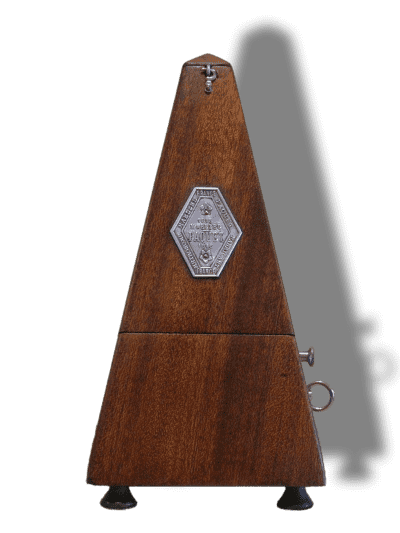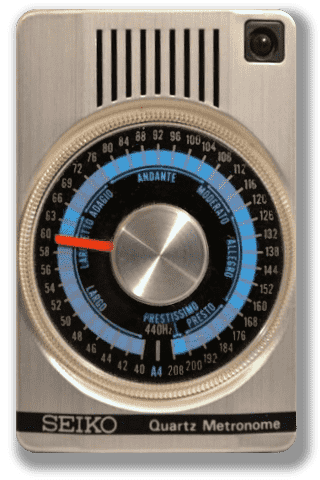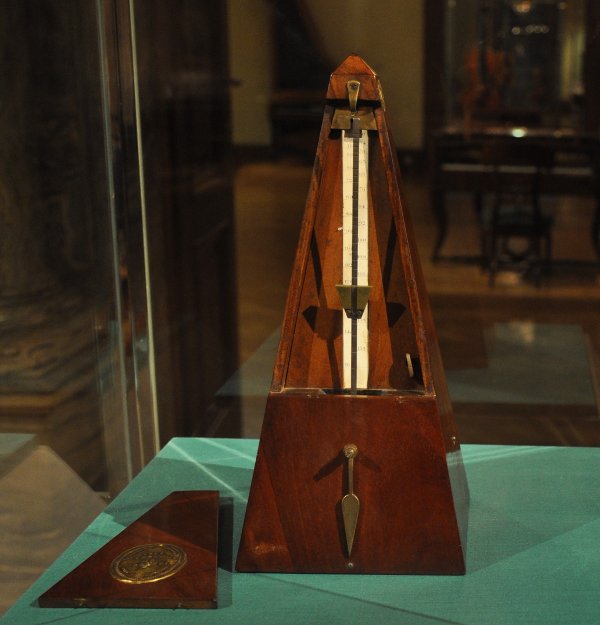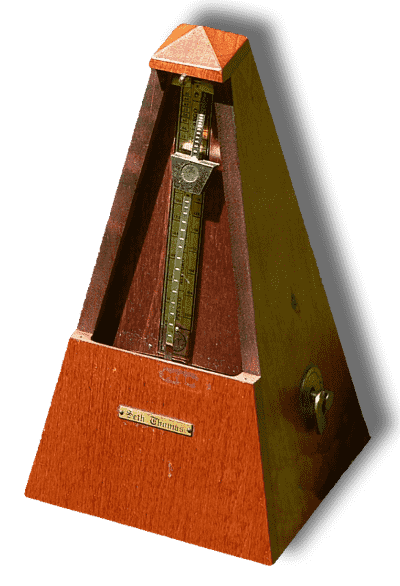 Metronome is to music what compass is to navigation... said the Institut de France when this pendulum instrument was first invented.
Since that time, the metronome has never ceased to strain the spirit and abilities of the musicians.
Indeed, who hasn't experienced these difficult rehearsal sessions where the metronome imposes stubborn tempo ?
Metronome is to music what compass is to navigation... said the Institut de France when this pendulum instrument was first invented.
Since that time, the metronome has never ceased to strain the spirit and abilities of the musicians.
Indeed, who hasn't experienced these difficult rehearsal sessions where the metronome imposes stubborn tempo ?
 Thank you, my metronome! You, Well known little tool that measures and splits time, you are never awarded enough to train us with your perfect and accurate musical beat! However, countless musicians have earned, by dint of self-sacrifice, the stripes of a solid musical technique after having bravely climbed, step by step, the notches of your graduated ruler...
Thank you, my metronome! You, Well known little tool that measures and splits time, you are never awarded enough to train us with your perfect and accurate musical beat! However, countless musicians have earned, by dint of self-sacrifice, the stripes of a solid musical technique after having bravely climbed, step by step, the notches of your graduated ruler...
And you, musicians, don't worry, you are not alone in having blamed it! Even Beethoven, at first very interested in invention, finally declared:
"No metronome at all! He who has a good feeling needs none, and it will be of no use to him who lacks this talent."
More than 200 years of use by musicians from every walk of life lead us to believe that it still has a certain usefulness...
But How Did It Come to This?
It all began in 1696 when a Mr. Étienne Loulié (1654-1702), musician, professor and theorist of his state, invented a system known as "chronomètre" based on Galileo's seconds pendulum. The object does not emit any sound, but it provides good tempo stability.
You only have to observe the pendulum swing to find the moment when the wire passes through the center of the body... and that's the tempo!
The invention was noticed enough to be rewarded by the Academy of Sciences.
 A few years later, Dietrich Nikolauss Winkel (1777-1826) was a clockmaker in Holland.
Fascinated by these mechanisms, Dietrich lives and breathes for the art of horology! In 1812, he proves that a pendulum can have regular beatings provided it is weighted on both sides of the axis.
His technical skills then allowed him to design a musical chronometer with very regular beats, even at slower tempi.
In 1814, he donated his first copy to the Royal Netherlands Academy of Arts and Sciences.
Winkel's enthusiasm for the mechanics of time did not allow him to take advantage of his discovery. Someone else, Johann Nepomuk Mälzel, was going to do it without his knowledge. For Winkel, time was only science, but for Mälzel, time was money...
A few years later, Dietrich Nikolauss Winkel (1777-1826) was a clockmaker in Holland.
Fascinated by these mechanisms, Dietrich lives and breathes for the art of horology! In 1812, he proves that a pendulum can have regular beatings provided it is weighted on both sides of the axis.
His technical skills then allowed him to design a musical chronometer with very regular beats, even at slower tempi.
In 1814, he donated his first copy to the Royal Netherlands Academy of Arts and Sciences.
Winkel's enthusiasm for the mechanics of time did not allow him to take advantage of his discovery. Someone else, Johann Nepomuk Mälzel, was going to do it without his knowledge. For Winkel, time was only science, but for Mälzel, time was money...
Taking credit for Winkel's invention, Maelzel filed a French patent application in 1815 "for a kind of chronometer called a metronome for use in music". Once this patent was granted, he added a graduated scale of tempi to the metronome and filed a new patent in 1816 in England. He legally became the father of the mechanical metronome still in use today.
And since then, we've all been there!
 Tick, tock, tick, tock. This high-precision virtual metronome is made available to you by
Tick, tock, tick, tock. This high-precision virtual metronome is made available to you by  Metronome is to music what compass is to navigation... said the Institut de France when this pendulum instrument was first invented.
Since that time, the metronome has never ceased to strain the spirit and abilities of the musicians.
Indeed, who hasn't experienced these difficult rehearsal sessions where the metronome imposes stubborn tempo ?
Metronome is to music what compass is to navigation... said the Institut de France when this pendulum instrument was first invented.
Since that time, the metronome has never ceased to strain the spirit and abilities of the musicians.
Indeed, who hasn't experienced these difficult rehearsal sessions where the metronome imposes stubborn tempo ?
 Thank you, my metronome! You, Well known little tool that measures and splits time, you are never awarded enough to train us with your perfect and accurate musical beat! However, countless musicians have earned, by dint of self-sacrifice, the stripes of a solid musical technique after having bravely climbed, step by step, the notches of your graduated ruler...
Thank you, my metronome! You, Well known little tool that measures and splits time, you are never awarded enough to train us with your perfect and accurate musical beat! However, countless musicians have earned, by dint of self-sacrifice, the stripes of a solid musical technique after having bravely climbed, step by step, the notches of your graduated ruler...
 A few years later, Dietrich Nikolauss Winkel (1777-1826) was a clockmaker in Holland.
Fascinated by these mechanisms, Dietrich lives and breathes for the art of horology! In 1812, he proves that a pendulum can have regular beatings provided it is weighted on both sides of the axis.
His technical skills then allowed him to design a musical chronometer with very regular beats, even at slower tempi.
In 1814, he donated his first copy to the Royal Netherlands Academy of Arts and Sciences.
Winkel's enthusiasm for the mechanics of time did not allow him to take advantage of his discovery. Someone else, Johann Nepomuk Mälzel, was going to do it without his knowledge. For Winkel, time was only science, but for Mälzel, time was money...
A few years later, Dietrich Nikolauss Winkel (1777-1826) was a clockmaker in Holland.
Fascinated by these mechanisms, Dietrich lives and breathes for the art of horology! In 1812, he proves that a pendulum can have regular beatings provided it is weighted on both sides of the axis.
His technical skills then allowed him to design a musical chronometer with very regular beats, even at slower tempi.
In 1814, he donated his first copy to the Royal Netherlands Academy of Arts and Sciences.
Winkel's enthusiasm for the mechanics of time did not allow him to take advantage of his discovery. Someone else, Johann Nepomuk Mälzel, was going to do it without his knowledge. For Winkel, time was only science, but for Mälzel, time was money...
 it's up to each of us to do our own methodical tick-tock analysis.
Make up your own mind by listening to the
it's up to each of us to do our own methodical tick-tock analysis.
Make up your own mind by listening to the